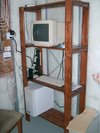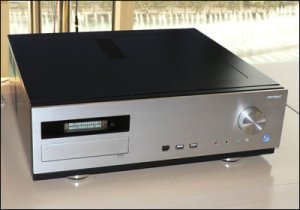Posts in category 'technology'
The Problems Begin
Things were going so well. The MythTV Backend is now built and humming away quietly in my basement, Fedora Core installed and working nicely. The only minor glitch being some issues with the onboard NIC, though nothing that can’t be solved. Really, it was all going too well.
And then the other shoe dropped.
PVR Problems
A couple of days ago, the board for my Living Room Frontend finally arrived after much waiting, whining, complaining, etc. When it finally showed up, I eagerly went home and mounted the board in the lovely Antec case I bought (at which point I realized the EPIA board could also fit in micro-ITX case… it looked so tiny in the mini-ITX Antec). I then wired up all the connectors, routed all the wiring nice and cleanly, and then went to install the RAM. Which didn’t fit. Why? Well, you see, I ordered DDR memory. I then decided to opt for the EPIA EN12000EG instead of the M6000. The M6000 takes DDR. The EN… takes DDR2. $80 blown. Doh.
So, today, after running some errands, we stopped by BEST and I picked up a stick of DDR2. Then, after dinner, I installed the stick and powered up the board. And nothing.
Actually, that’s not true. The PSU and case ventilation fans spun up, even though the power switch hadn’t been pressed. Not good. Experienced computer builders will immediately recognize the potential problem this presents.
So, I decided to start trouble shooting. The first thing was to make sure the PSU wasn’t at fault, so I disconnected the ATX connector from the motherboard and flipped the power switch. Nothing. Nada. This ruled out the PSU.
I then proceeded to reconnect the ATX connector and begin disconnecting other things gradually, testing the PSU in between. And every time, the fans spun up. Eventually, I was left with just the ATX connector attached to the board and nothing else. No RAM. No connectors. Nothing. And when I hit the power switch… the fans spun up. Conclusion? Bad motherboard. Grrr…
So now I have to return the board and get a replacement. Looks like no PVR for at least a few more weeks. On the bright side, at least I can get the backend finished up.
Incidentally, in the process of looking up resources on how to debug this problem, I found this forum post (second one down) describing the process of troubleshooting a motherboard. I mirrored the content here just in case the forum link disappears.
Wiring Hell
Meanwhile, I figured it would be a good idea to get the networking wired up to the living room. Now, my plan was to reuse the existing coaxial outlet as the ethernet jack. This is particularly convenient, in my case, because I’m dropping down between floors. You see, in this case, when dropping cable from scratch, it’s necessary to drive a hole between the lower wall framing plate and the subfloor. This means augering a hole through four inches of wood… not fun, especially if you don’t want to damage the wall. However, because I was reusing the coax connection, this hole had already been cut, making my job much easier.
Thus, all I needed to do was drop a piece of cat5 around twelve inches straight down into the basement. Easy, right? Well, unfortunately, it wasn’t that easy. You see:
- The coax utility box can’t be moved out of the way, because it’s fixed to the stud,
- I’m dropping through an exterior wall, which means insulation, which gets in the way,
- Because it’s an external wall, the box is surrounded by a PVC boot, making it more difficult to access from below,
- The hole in the basement is located near the exterior wall, over the existing framing, making it awkward to reach,
- The existing coax is fixed inside the wall, meaning it can’t be moved (or used to drag the cat5 through).
Now, the only workable method was to use a coat hanger to fish upward from the basement to the coax box. Once I reached it, the plan was to fix the cat5 to the coat hanger and draw it down into the basement. Things did not work out so well. I eventually gave up at 12:30 last night, after around 4 hours poking and prodding inside my walls.
So, what now? Well, Chris, a buddy from work, said he might come by on Saturday and give me a hand. Hopefully, between the two of us, we can get the cable run. Of course, until the EPIA replacement arrives, it won’t actually get connected to anything…
And It Begins
That’s right… things have started arriving! In particular, most of my NCIX-ordered items arrived, which allowed me to build my MythTV Backend and begin the software installation process. I’ve now got Fedora Core 5 installed and a bunch of services configured (though, without the Living Room Frontend ready, I can only get so much done).
Speaking of the frontend, the case has arrived! So, of course, I had to take a picture:
It’s bigger than I’d imagined, for some reason… about the size of a stereo receiver, and weighing in at a whopping 17lbs! Of course, this is, in part, because of the steel used in most of it’s construction. But, I gotta say… it’s pretty awesome. :) And it’ll fit perfectly in the TV stand.
Anyway, the EPIA board will likely arrive tomorrow (they apparently tried to deliver today, but I owe them money, presumably duty), and that only leaves the remaining NCIX items (which got shipped today) and the IR blaster/receiver, which are in the mail as I type this. At which point the fun will really begin!
Nesting...
Well, with all the hardware for the MythTV project on the way (mostly, anyway… NCIX didn’t have a couple items in stock. Like the TV capture card), it seemed like a good time to get the house in order for the new arrivals. Thus, as a logical first step, I decided it was about time I got my firewall rebuilt and moved all the various networking bits downstairs onto some kind of shelving. The result is this:
As you can see, I re-purposed an old Ikea shelving unit as a make-shift rack, and then moved all these things downstairs:
- Cable Modem
- 10Mbs hub (until I get a proper switch for the main house LAN)
- 10/100Mbs switch for the MythTV LAN
- Firewall
In case you’re wondering, this gear is all set up like so:
[[fig:Home Network Diagram]]
Why so complicated? Well, the primary complication is in my choice to shunt the MythTV stuff onto it’s own subnet. I had a couple reasons for this:
- The MythTV frontends will be configured via DHCP and bootp. Putting this on a separate network prevents conflicts with the main firewall DHCP (and any other network-booted devices I may deploy).
- I figured a dedicated, switched 100Mbs network for the Myth stuff wasn’t a bad thing.
Of course, if I had a proper switch which supported VLANs, I could have done this with a single switch, but I wasn’t prepared to pay the bucks for such a device.
As for the firewall, I ended up abandoning LEAF in favour of m0n0wall, a FreeBSD-based firewall that boots nicely off a mini-CD and writes it’s configuration to a dirt cheap USB flash drive I plugged into the back of the thing (IOW, no more unreliable floppies!). And as a bonus, it has a nice, easy to use web-based admin interface, so no longer do I have to hook a damn monitor up to the thing every time I want to reconfigure things.
Another Project???
Okay, this one’s a little different, though. I swear. It costs a lot more than my previous projects…
So what is it? Well, for many months now, I’ve talked on and off about building a DIY PVR setup. Usually this starts off with me complaining about the timeslots for The Daily Show and The Colbert Report, and quickly turns into a discussion of how awesome a PVR would be for timeshifting my favorite shows, listening to all the music I’ve transferred onto my computer, and watching all the content I’ve downlo… err… ahem. Anyway, as a result, I’ve often thought about:
- Buying and modding an XBox,
- Building a MythTV-based system, or
- Buying a Shaw PVR.
But it wasn’t until I got my pay adjustment, and the attendant backpay (all the way back to last december!) that it became a practical possibility. The problem is, now flush with cash, I think I’ve gone a little overboard.
It all started with plans to build a simple MythTV-based PVR with a mini-itx board of some kind, mounted in a little case. It didn’t take long before this ballooned into a full frontend/backend networked multimedia infrastructure project, with all it’s associated costs. But you know what? I don’t care, damnit! :)
Anyway, I’ve started some new pages to cover my MythTV project. There you can read about my motivations, details about MythTV, and the hardware I’m using. As for the current status, the gear has all been ordered and should arrive in the next few weeks, at which point, the fun begins! Meanwhile, I’ll need to string some cat5e between my living room and where the backend will live, so that should keep me busy.
And just to give you a little taste, here is a shot of the case I’m going to use for the Living Room Frontend:


